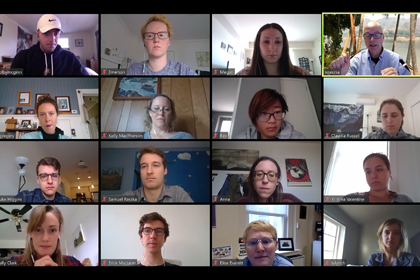For first-year students, the COVID-19 pandemic has meant the interruption of active learning sessions on campus as well as the suspension of the Doctoring in Vermont course that sends students into primary care offices throughout Vermont. Karen Lounsbury, Ph.D., director of the Foundations level of the Vermont Integrated Curriculum, says faculty have stepped up to the challenge the pandemic has presented.

Class of 2022 medical students take part in a Zoom meeting with Professor of Pediatrics William Raszka, Jr., M.D., and Associate Professor of Obstetrics, Gynecology and Reproductive Sciences Elise Everett, M.D.
With clinical rotations for all medical students suspended and classroom learning on hold during this phase of the COVID-19 pandemic, faculty have pivoted to remote learning–and have rapidly developed several new elective courses–to ensure students receive the education they deserve and acquire the necessary skills to become physicians.
For first-year students, the COVID-19 pandemic has meant the interruption of active learning sessions on campus as well as the suspension of the Doctoring in Vermont course that sends students into primary care offices throughout Vermont. Karen Lounsbury, Ph.D., director of the Foundations level of the Vermont Integrated Curriculum, says faculty have stepped up to the challenge the pandemic has presented. Rebecca Wilcox, M.D., course director for Nutrition, Gastrointestinal and Metabolic Systems, worked closely with the College’s curriculum and information technology teams to move to remote instruction as of March 16. Although students already work with online materials throughout every course in the Foundations level, Wilcox and faculty who teach in the course had to move in-person sessions that use small group discussions, team-based learning, and other teaching methods to remote instruction.
Students worked independently with recorded sessions and clinical case study questions, and then had live integrated review sessions with Wilcox three times per week, while discussion boards facilitated peer teaching. For Professionalism, Communication and Reflection, a 42-week course that relies on in-person discussion, students met in small groups with their preceptors using Zoom.
The College’s IT team quickly developed the infrastructure to deliver exams remotely via secure exam browser.
“We had a COMTS tech team available by phone throughout the exam,” Lounsbury says. “We had a couple of technical issues that were addressed immediately and all students were able to complete the exam.”
With a timeline to return to the classroom uncertain, faculty have applied lessons to the next Foundations course: Medical Neuroscience.
“We are using the experience with NMGI to help inform how we are proceeding with the remote delivery of Medical Neuroscience,” says Lounsbury. “That course has an anatomy component, and the anatomists were able to video the neuroanatomy specimens before the full stay at home order, so we will be able to deliver that content virtually.”
For students in the clerkship year, Elise Everett, M.D., level director of the clinical curriculum, says the goal is to concentrate on what they can learn without entering a hospital or clinic.
“We've been focusing on medical knowledge,” she says. “This allows us to delay their entry into the clinical setting so that when they do enter the clinical setting, one, they'll be very knowledgeable, and two, they can focus on the things that need to be learned at the bedside, such as physical exam skills and critical thinking."
The schedule for the Vermont Integrated Curriculum – which would have had students beginning their clerkships in mid-March - affords some advantage as compared to other medical schools who may have had to pull students out of rotations that had already started. The timeline allowed faculty and the College’s active learning team to quickly create several courses to fill the void created by the delay.
This included a new COVID-19 reading month, where small groups of students, along with an expert faculty member, studied aspects of the current pandemic, including the impact on vulnerable populations and the elderly, the science of social distancing, communication during a pandemic, and the ethics of providing care in resource-limited settings.
The College also offered the Advanced Integration medical Spanish elective course for clerkship students as an alternative to the COVID-19 reading month, and a telehealth elective course is in the works. Other aspects of clerkship year are being transitioned to remote instruction, including Clerkship Orientation, Bridge Weeks and individual clerkship orientations, again with a goal to facilitate rapid entry into the clinical environment when the time comes.
For rising fourth year students entering Advanced Integration, the pandemic has interrupted what would have been a time to explore career options and specialties they are interested in. Away rotations for fourth-year students are expected to be cancelled, says Everett, an eventuality medical education leaders are preparing for. Although the challenges the pandemic creates for the Class of 2021 are significant, the VIC also provide one advantage.
“Luckily for us, again because of our schedule, we start our fourth year in March and most other schools don't start their fourth year until June or July,” she says. “We do have a couple extra months of wiggle room.”
Like medical schools across the country, the College awaits further guidance from the Association of American Medical Colleges regarding whether the September 15, 2020, application deadline for residency programs will be delayed. One challenge is not knowing exactly when students will be able to enter hospitals and clinics again, whether it is at sites in Vermont, at the College’s branch campus in Connecticut, or the Longitudinal Integrated Clerkship sites in New York State and central Vermont. As Everett continues to work with faculty to revise schedules and contingency plans, she does see an opportunity to improve.
“Certainly, it's allowed us to take a very close look at the curriculum and focus on what our goals and objectives are, identifying areas where we're meeting them and areas where we can streamline.”